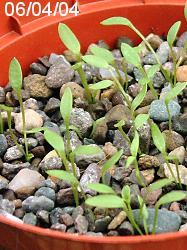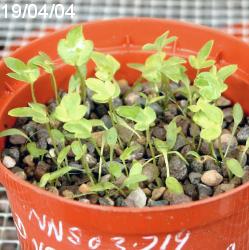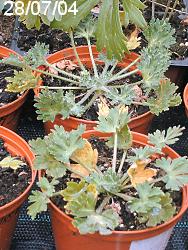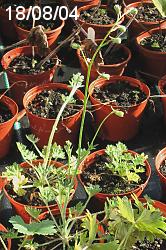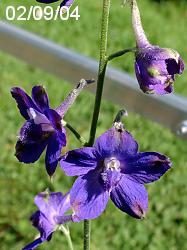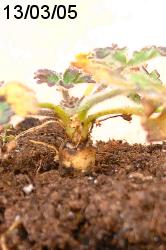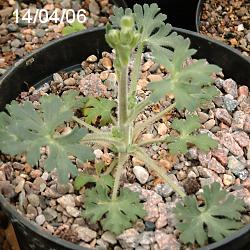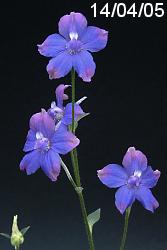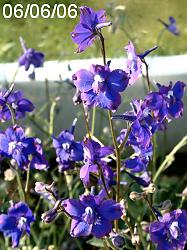| North
American Delphinium Species |
A guide to stages in seedling development
D. variegatum the
'Royal Larkspur', is found only in California. It is a common
plant of grassland and open oak woodland in the foothills of the
Coast Range, Cascade Ranges and Sierra Nevada, plants at times
colouring foothills. It is short-growing, with flower stems from
15 - 50cm tall bearing royal blue or purple-blue flowers in April/May
that can be exceptionally large relative to the size of the plant.
This species was grown from
seed supplied by Northwest Native Seeds collected from plants
growing in grassland on heavy rocky clay soil in the inner
Northern Coast ranges of Lake County, California, about 100miles
north of San Francisco. The tiny seeds differ from the dark brown
seeds of familiar garden delphiniums in having a white outer coat.
They were sown in late January on the surface of peat-based
compost in a 9cm pot and lightly covered with compost and a layer
of grit. The pot was left outdoors exposed to the weather but
protected from birds and mice by wire mesh. Germination began in
early March. Seedlings were very small compared to those of most
delphiniums but had the familiar form with a pair of narrow seed
leaves on separate stalks and their first true leaf grew from the
point where the cotyledon stalks joined the root, as seen in the
pictures below. This is characteristic of delphiniums with a
fibrous root rather than the tuberous roots of many species from
the USA. Seedlings were pricked out into individual pots in late
April.
The plants grew slowly,
developing a rosette of small but extensively divided leaves with
relatively long stalks. Both leaves and stalks are covered in
hairs. The plants remained small, hardly extending beyond the rim
of their 9cm pots even in early August, as seen in the right hand
picture above. Yellowing of the leaves suggested that most were
likely to die or go dormant, as most did, rather than to continue
growing. Torrential rain associated with a thunderstorm then
brought about a miraculous transformation in the surviving plants.
Within a few days, two plants suddenly had stems with a cluster
of tiny flower buds pushing up from the base. By the end of
August these provided a taste of Californian spring, as these
plants were in flower with 8 or more large, flat florets held on
slender but stiff stems almost 30cm (1ft) tall.
After flowering, plants become
dormant. Some have been kept under glass so that compost in the
pots dries out, while others have been kept in the open where
they are subject to rainfall throughout summer and autumn.
Survival of the plants has been fairly good and examination of
the plants as they start into growth in early spring (or even in
mid-winter) shows that the new flower stems develop from the top
of a thickened root, as seen on the right above.
Repotting the plants when new
growth first appeared did not cause problems and the plants
develop quickly to flower in Spring. In 2006 when weather
conditions in the Spring were unfavourable for plant growth,
flowering extended into June.The multiple stems of plants in
their third season then provided a fine display of flowers
followed by well-filled seed pods. The flowers ranged from a few
good pure blues but most had extensive purple colouration on the
tips of sepals.
